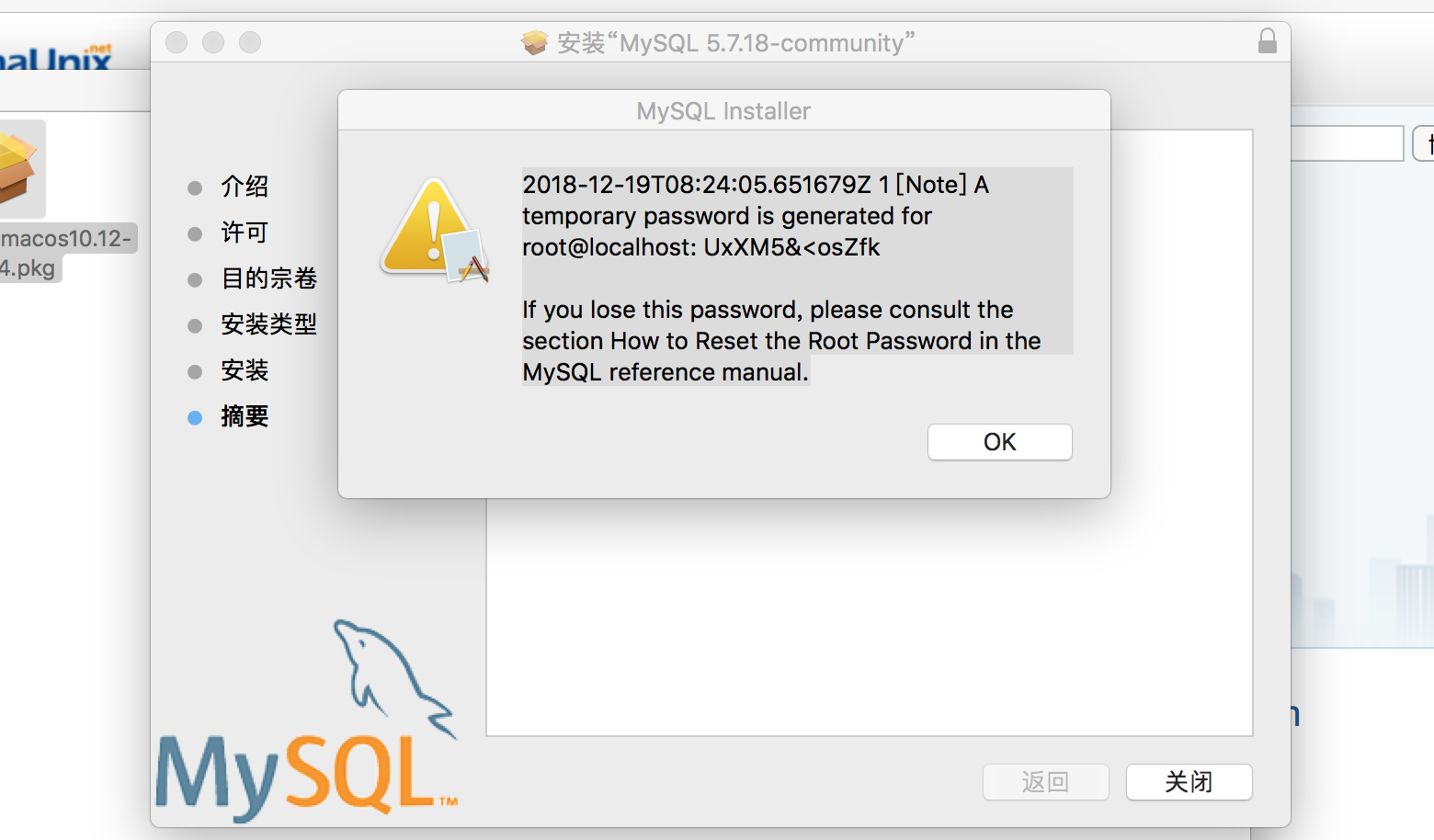1. mysql的卸载
- 1 sudo rm /usr/local/mysql
- 2 sudo rm -rf /usr/local/mysql*
- 3 sudo rm -rf /Library/StartupItems/MySQLCOM
- 4 sudo rm -rf /Library/PreferencePanes/My*
- 5 vim /etc/hostconfig (and removed the line MYSQLCOM=-YES-)
- 6 rm -rf ~/Library/PreferencePanes/My*
- 7 sudo rm -rf /Library/Receipts/mysql*
- 8 sudo rm -rf /Library/Receipts/MySQL*
- 9 sudo rm -rf /var/db/receipts/com.mysql.*
在我的mac上没有Library文件夹,故6、7、8操作执行
2.下载mysql免费版(可以用brew install mysql 但是安装的都是最新的版本)
- https://downloads.mysql.com/archives/community/

3.下载后dmg文件后,双击后一步步安转
4.安装最后一步会生成一个密码,此密码是mysql自动生成的密码

5. 启动mysql服务
sudo mysqld --user=mysql & //不能用root用户启动
输入刚才生成的密码

5. 修改数据库密码
SET PASSWORD FOR'root'@'localhost'=PASSWORD('new password');flush privileges;
6. 安装mysql后配置环境变量,以便使用mysql命令
- vi ~/.zshrc 不存在就新建
- 然后输入 export PATH=${PATH}:/usr/local/mysql/bin
- 保存后 source ~/.zshrc
7. 启动、停止和重启
- 启动MySQL服务
sudo /usr/local/MySQL/support-files/mysql.server start
- 停止MySQL服务
sudo /usr/local/mysql/support-files/mysql.server stop
- 重启MySQL服务
sudo /usr/local/mysql/support-files/mysql.server restart
8. 在/usr/local/mysql/support-files创建my.cnf文件(mac默认没有此文件),并给于666权限,才可以编辑
# Example MySQL config file for small systems. # # This is for a system with little memory (<= 64M) where MySQL is only used # from time to time and it's important that the mysqld daemon # doesn't use much resources. # # MySQL programs look for option files in a set of # locations which depend on the deployment platform. # You can copy this option file to one of those # locations. For information about these locations, see: # http://dev.mysql.com/doc/mysql/en/option-files.html # # In this file, you can use all long options that a program supports. # If you want to know which options a program supports, run the program # with the "--help" option. # The following options will be passed to all MySQL clients [client] default-character-set=utf8 #password = your_password port = 3306 socket = /tmp/mysql.sock # Here follows entries for some specific programs # The MySQL server [mysqld] default-storage-engine=INNODB character-set-server=utf8 collation-server=utf8_general_ci port = 3306 socket = /tmp/mysql.sock skip-external-locking key_buffer_size = 16K max_allowed_packet = 1M table_open_cache = 4 sort_buffer_size = 64K read_buffer_size = 256K read_rnd_buffer_size = 256K net_buffer_length = 2K thread_stack = 128K # Don't listen on a TCP/IP port at all. This can be a security enhancement, # if all processes that need to connect to mysqld run on the same host. # All interaction with mysqld must be made via Unix sockets or named pipes. # Note that using this option without enabling named pipes on Windows # (using the "enable-named-pipe" option) will render mysqld useless! # #skip-networking server-id = 1 # Uncomment the following if you want to log updates #log-bin=mysql-bin # binary logging format - mixed recommended #binlog_format=mixed # Causes updates to non-transactional engines using statement format to be # written directly to binary log. Before using this option make sure that # there are no dependencies between transactional and non-transactional # tables such as in the statement INSERT INTO t_myisam SELECT * FROM # t_innodb; otherwise, slaves may diverge from the master. #binlog_direct_non_transactional_updates=TRUE # Uncomment the following if you are using InnoDB tables #innodb_data_home_dir = /usr/local/mysql/data #innodb_data_file_path = ibdata1:10M:autoextend #innodb_log_group_home_dir = /usr/local/mysql/data # You can set .._buffer_pool_size up to 50 - 80 % # of RAM but beware of setting memory usage too high #innodb_buffer_pool_size = 16M #innodb_additional_mem_pool_size = 2M # Set .._log_file_size to 25 % of buffer pool size #innodb_log_file_size = 5M #innodb_log_buffer_size = 8M #innodb_flush_log_at_trx_commit = 1 #innodb_lock_wait_timeout = 50 [mysqldump] quick max_allowed_packet = 16M [mysql] no-auto-rehash # Remove the next comment character if you are not familiar with SQL #safe-updates [myisamchk] key_buffer_size = 8M sort_buffer_size = 8M [mysqlhotcopy] interactive-timeout
- touch my.cnf
- sudo chmod 666 my.cnf
修改完后,再执行
- sudo chmod 664 /etc/my.cnf
9.查询mysql进程
- mysql.server status
10.查询mysql状态
- mysql.server status